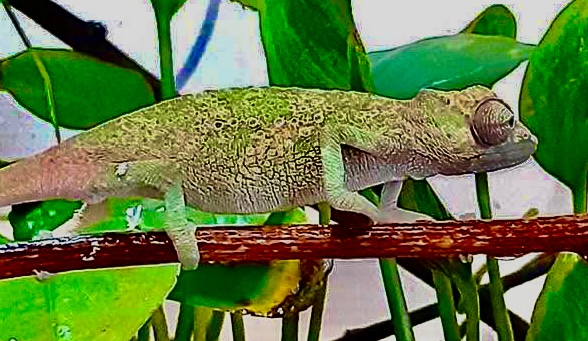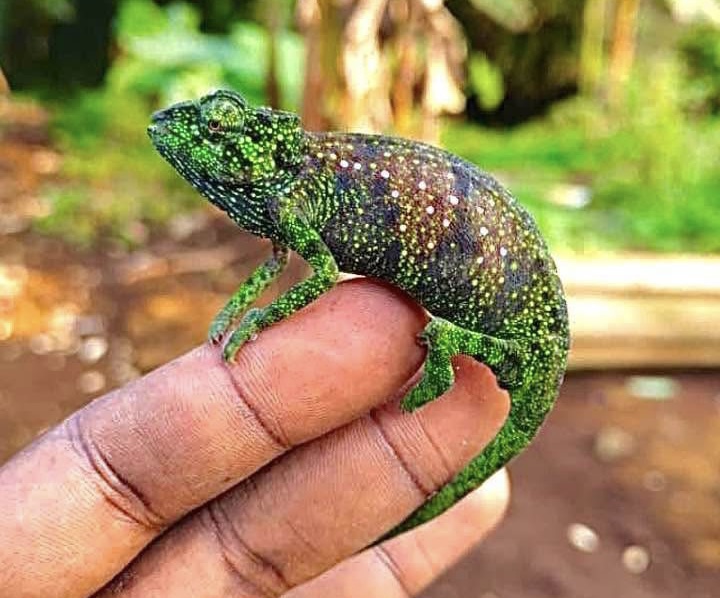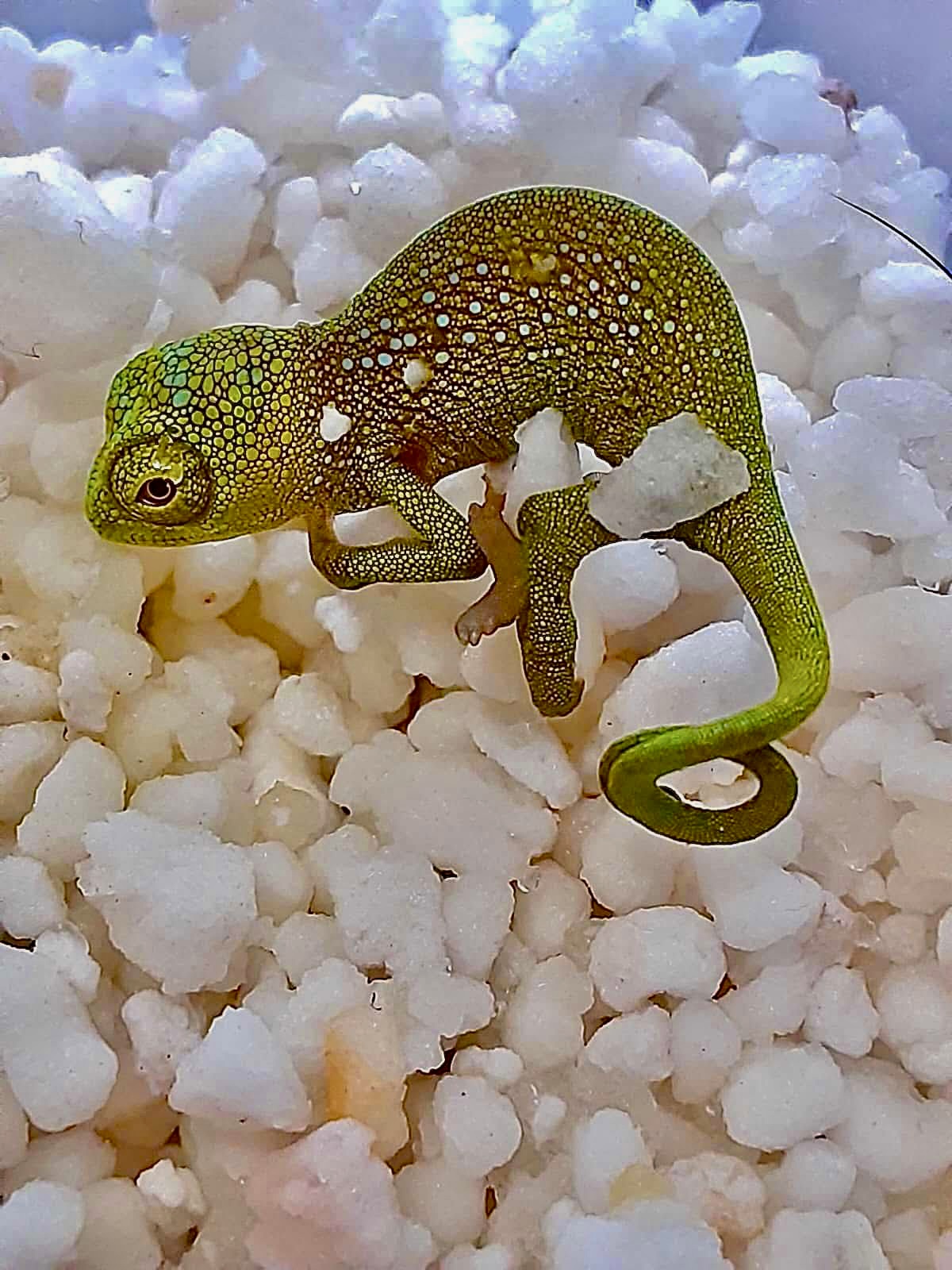Barely Seen, Deeply Fascinating: The Lowland Enigma Trioceros camerunensis
By Petr Nečas & Jürgen van Overbeke



Abstract
Trioceros camerunensis is one of the rarest chameleon species known; it is almost unknown and only a few museum specimens exist. It has been depicted only a handful of times, so almost no one knows what it looks like in life. Its biology remains a mystery. This article presents a comprehensive overview of the species, synthesizing systematic classification, morphology, biogeography, and detailed captive husbandry based on firsthand breeding experience. T. camerunensis occurs exclusively in lowland rainforest habitats, unlike its montane relatives, and has been observed in nature only three times over two decades. Captive protocols derived from closely related Trioceros montium provide viable husbandry guidelines. This synthesis contributes new context to a species long overlooked by science and invites greater interest in its conservation.
Keywords: Trioceros camerunensis, Cameroon chameleon, lowland rainforest, T. cristatus group, captive husbandry, rare species, taxonomy, endemic fauna, conservation biology
Systematics and Affiliation
Trioceros camerunensis was described by Müller in 1909 as Chamaeleon camerunensis (Jb. nassau. Ver. Naturk. Wiesbaden 62: 111) from Dibongo near Edea (Cameroon) and belongs nowadays to the genus Trioceros. It is a part of the Trioceros cristatus group, to which the following forms belong:
Trioceros camerunensis (Müller, 1909)
Trioceros cristatus (Stutchbury, 1837)
Trioceros eisentrauti (Mertens, 1968)
Trioceros feae (Boulenger, 1906)
Trioceros montium (Buchholz, 1874)
Trioceros perreti (Tornier, 1900)
Trioceros pfefferi (Tornier, 1900)
Trioceros quadricornis quadricornis (Tornier, 1899)
Trioceros quadricornis gracilior (Böhme & Klaver, 1981)
Trioceros serratus (Mertens, 1922)
Trioceros wiedersheimi (Nieden, 1910)
The species of the Trioceros cristatus group received relatively little attention in the past due to scarcity of collection material of the species such as Trioceros camerunensis, eisentrauti, pfefferi and due to their limited distribution to relatively inaccessible locations in Cameroon and surrounding countries. Most of the species of this complex are only found in relict patches of montane rainforest confined to mountains or mountain ranges in the Cameroon-Nigerian hinterland and T. feae occurs in a similar habitat on the peaks of Fernando Poo (Bioko). Trioceros montium has a (sub-)montane distribution on mountains nearest to the coast. Trioceros cristatus is a widespread lowland species, recorded from the lowland rainforest of Ghana, Togo, Nigeria, Cameroon, Equatorial Guinea (Mbini and Bioko), Gabon, Central African Republic and Congo. Trioceros camerunensis is a lowland species with a distribution limited to the coastal plains south of Mt Cameroon, reaching Congo. It is one of the rarest species of the group.
Mertens (1964) classified T. camerunensis as a subspecies of T. montium, but Klaver and Böhme (1992) reclassified it as a valid species. Molecular data support a close relationship between T. camerunensis and T. montium, while Pook and Wild (1997) suggest stronger genetic affinity to T. feae.
Morphology and Anatomy
Head: Casque flat and only slightly raised posteriorly, pointed at the end; lateral crest weakly developed anteriorly of the point where the temporal crest meets, from this point to the extremity of the casque it is well developed and consists of triangular tubercles; triangle between anterior part of the lateral crest and the temporal crest covered with somewhat larger round convex scales; scales on top of the head and in the temporal region slightly enlarged and polygonal; gular scales somewhat larger than the scales on the body; no parietal crest, horns, or gular crest.
Body: Covered with small flat scales intermixed with numerous somewhat enlarged rotund flat scales that sometimes form longitudinal rows on the upper flanks; no dorsal and caudal keel, but dorsum and anterior part of the tail slightly crenulate in males; at neural spines, a somewhat enlarged flat scale is present; outer margin of the dorsum with a double row of scales; no ventral crest.
Dimensions:
♂: HBL/TL 90/106 mm (ZSM 488/1916)
♀: HBL/TL 85/96 mm (SMF 16459)
Hemipenis: Truncus with small shallow calyces; four denticulated rotulae on the apex; near the base of each sulcal rotula, a papillary field with up to 10 fleshy papillae.
Lung morphology: A smooth muscle network covers the entire luminal surface; four or five diverticula may be present; two large septa of unequal size are connected with the lateral, medial and ventral lung wall; they subdivide the lumen into three successive chambers. The two posterior chambers terminate in a diverticulum, while the remaining 2–3 diverticula are always attached to the most posterior chamber. A diaphragm and three small dorsal septa are present. A gular pouch is absent.
Distribution and Natural History
Range: Coastal plains south of Mt. Cameroon Type locality: Dibongo near Edea
Known from: Cameroon: Isongo, Dehane, Metet, Sakbayeme, Bibundi; Congo: Baposo
Biotope: Dense lowland forest areas near sea level in the coastal zones of Cameroon and Congo. Despite two decades of targeted fieldwork by local experts, T. camerunensis has been observed in nature only three times (van Overbeke pers. comm. ad secundum), at levations up to 800m a.s.l.; often syntopic with T. cristatus.
Captive Husbandry Conservation status
Captive data are scarce. Successful breeding has been reported only a few times globally—twice in Europe, once in Japan (van Overbeke, pers.com.), in the USA, only few females were impoerted, no breeding report exists. Protocols follow closely those used for T. montium (Anderson et al. 2005), with critical updates reflecting the lowland habitat requirements of T. camerunensis.
Enclosure:
Screen terrariums with strong ventilation
Dense planting with ferns, Ficus benjamina, and Schefflera arboricola
Numerous thin horizontal and vertical branches for climbing
Individual housing preferred due to shyness
Climate control:
Daytime temperature: 21–24°C
Nighttime temperature: 18–19°C
Fogging: 1–1.5 hours at night
Misting: Morning and late afternoon
Minimal basking; temperatures above 25–26°C induce stress, temperatures below 18°C induce intense basking
Nutrition:
Preferred prey: flying insects (especially houseflies)
Avoiding synthetic vitamins to prevent edema
Supplementation: organic bee pollen
Gut-loading with dandelion leaves and endive for phosphorus-magnesium balance
Reproduction:
Gestation: ~2 months
Incubation: ~8 months at 19°C
Balanced sex ratio at optimal incubation temperature
Hatchlings thrive on micro-crickets, aphids, and tiny fruit flies
Juveniles housed in small groups in dense planted terrariums
Remarks:
Extraordinary secretive and shy species
Despite from lowland, does not tollerate high temperatures
Forest, shaded microbiotopes with little basking
Relatively easy to maintain adults and easy to raise juveniles
Conservation status
- IUCN: Least Concern (Tolley & Gonwouo 2014), though based on scarce dat
- CITES: Appendix II
- Captivity: Extremely rare, with limited breeding success globally
- Field Sightings: Only three documented in over 20 years (Harbort & Herrmann 2002)
Conclusions
Trioceros camerunensis stands as one of the most elusive jewels in the crown of African herpetofauna—rare in nature, barely known to science, and almost absent from captive collections. Its classification within the Trioceros cristatus group places it alongside a lineage of ecologically specialized chameleons, many of which occupy isolated montane ecosystems. Yet T. camerunensis breaks that mold, thriving instead in lowland rainforests where it remains hidden beneath the canopy, evading detection and defying assumption.
Despite having been scientifically described over a century ago, our understanding of the species remains fragmentary. Only through dedicated fieldwork, cautious observation, and meticulous husbandry efforts have glimpses of its life history emerged. The parallels with T. montium offer a practical bridge for advancing its captive care, but its temperament, ecological requirements, and physiological sensitivities demand tailored approaches.
As global biodiversity faces mounting pressures, species like Trioceros camerunensis remind us of the rich biological heritage still waiting to be documented, protected, and understood. Their obscurity is not insignificance—it is urgency. Bringing this species further into the light, both in scientific literature and conservation practice, could illuminate not only its biology but the fragile ecosystems it calls home.
References
Anderson, C. V., M. Coraggio & L. Kroo. 2005. Cameroon Mountain Two-Horned Chameleon, Chamaeleo (Trioceros) montium. Chameleons! Online E-Zine, June 2005.
Barej, M. F., I. Ineich, V. Gvoždík, N. Lhermitte-Vallarino, N. L. Gonwouo, M. LeBreton, U. Bott & A. Schmitz. 2010. Insights into Chameleons of the Genus Trioceros in Cameroon. Bonn Zoological Bulletin 57(2): 211–229.
Böhme, W. & C. J. J. Klaver. 1981. Zur Systematik der vierhörnigen Chamäleons: Beschreibung einer neuen Unterart Chamaeleo quadricornis gracilior subsp. n. aus Kamerun. Bonner Zoologische Beiträge 32(2): 229–242.
Harbort, J. & H.-W. Herrmann. 2002. Untersuchungen an ausgewählten Chamäleon-Populationen am Mt. Nlonako/Kamerun mit Bemerkungen zu einem Chamaeleo camerunensis. Herpetofauna 24(140): 25–34.
Klaver, C. J. J. & W. Böhme. 1992. The Species of the Chamaeleo cristatus Group from Cameroon and Adjacent Countries. Bonner Zoologische Beiträge 43(3): 433–476.
Mertens, R. 1964. Die Amphibien und Reptilien Westafrikas. Abhandlungen der Senckenbergischen Naturforschenden Gesellschaft 487: 1–96.
Müller, L. 1909. Vorläufige Mitteilung über ein neues Chamäleon aus Kamerun. Jahrbücher des Nassauischen Vereins für Naturkunde 62: 111. Available: https://dn721801.ca.archive.org/0/items/jahrbuch-nassauischen-verein-naturkunde-62-0111-0115/jahrbuch-nassauischen-verein-naturkunde-62-0111-0115.pdf
Nečas, P. 1999. Chameleons: Nature's Hidden Jewels. Frankfurt am Main: Edition Chimaira.
Pook, C. E. & C. Wild. 1997. Preliminary Phylogeny of Trioceros from Cameroon. Unpublished manuscript presented at the International Herpetological Symposium, Saint Louis Zoo.
Tolley, K. A. & N. L. Gonwouo. 2014. Trioceros camerunensis. The IUCN Red List of Threatened Species 2014: e.T203822A2771661. Retrieved from https://www.iucnredlist.org/species/203822/2771661..

